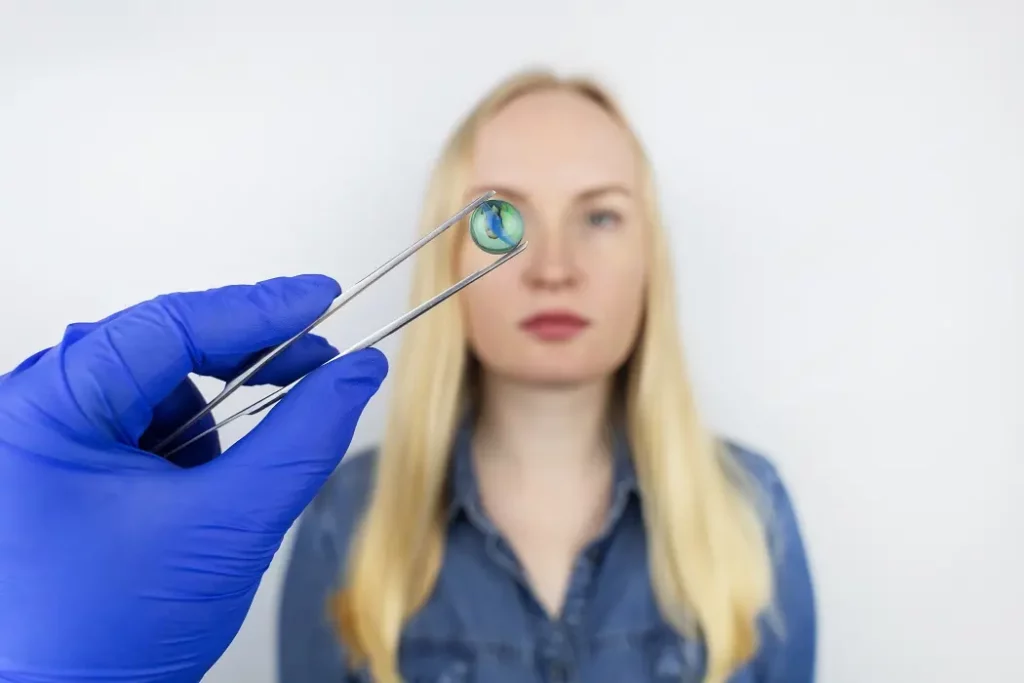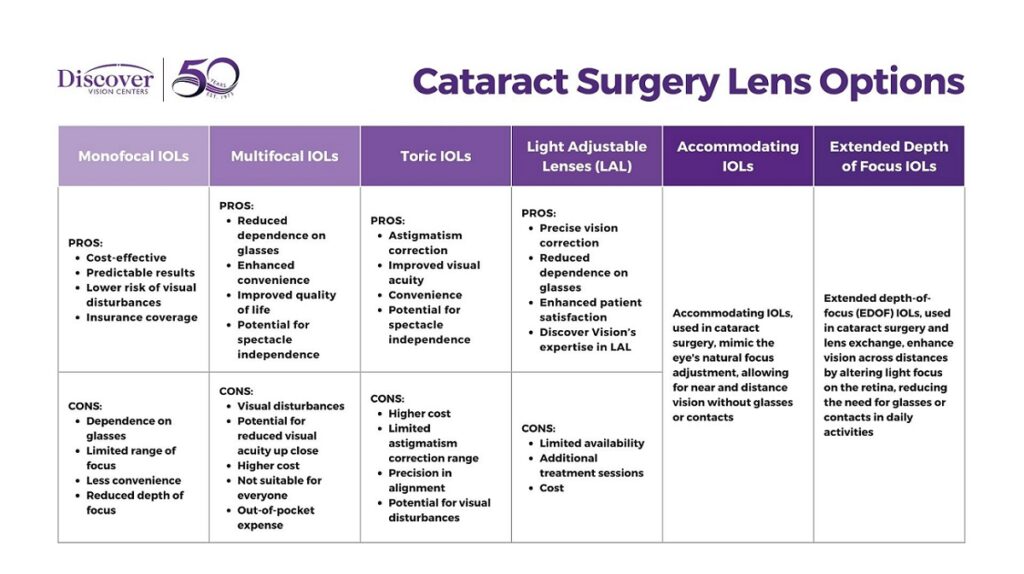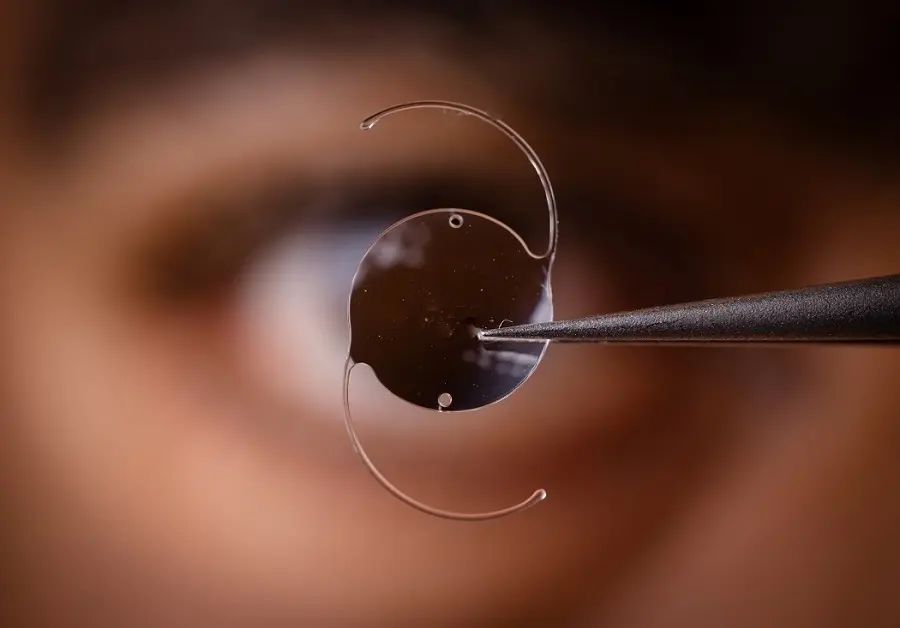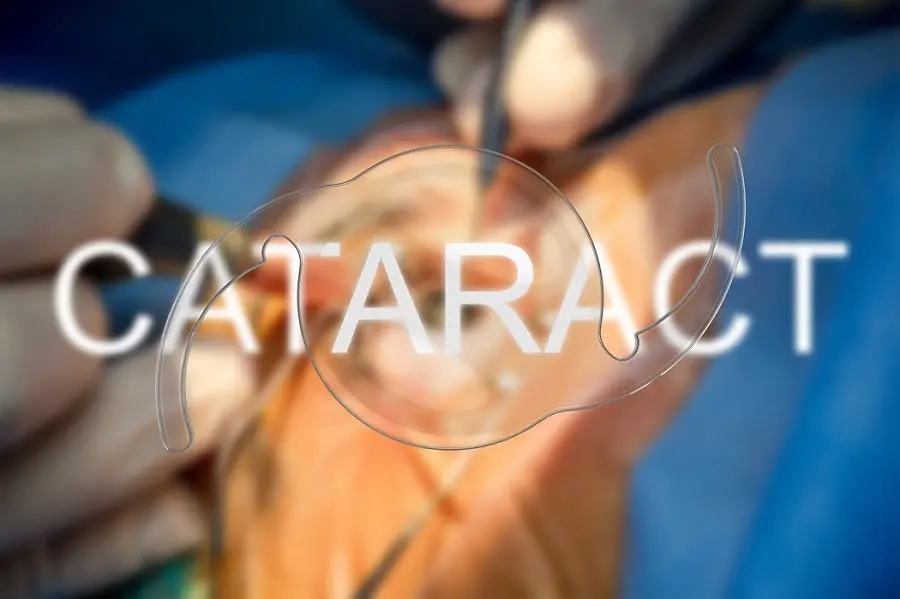
Updated: October 06, 2023

When it comes to treating cataracts, the most common and effective option is intraocular lens (IOL) surgery. This procedure involves replacing the cloudy natural lens with an artificial lens, improving vision clarity. However, with various types of cataract lenses available, selecting the right one for you can be overwhelming. Factors such as your lifestyle, visual needs, and any existing refractive errors like astigmatism or presbyopia must be considered. In this article, we will explore the different types of cataract lenses, including monofocal, multifocal, and accommodating lenses, to help you understand the options and make an informed decision regarding the best IOL for your cataract surgery.
Cataract surgery involves the removal of a cloudy natural lens and replacing it with an artificial lens called an intraocular lens (IOL). This innovative procedure aims to restore clear vision and improve the quality of life for individuals with cataracts. The IOL serves as a permanent replacement for the clouded lens, helping to focus light onto the retina, thereby enhancing vision. These artificial lenses are designed to address various visual needs, including distance vision, near vision, and astigmatism correction. By selecting the appropriate IOL, patients can experience improved visual acuity and reduced dependence on glasses or contact lenses following cataract surgery.
When undergoing cataract surgery, you have a range of lens options to consider. These lens options, known as intraocular lenses (IOLs), can help improve vision and reduce the need for glasses or contact lenses after surgery. From monofocal lenses that correct vision at a single distance to multifocal and toric lenses that address presbyopia and astigmatism, the choice of lens depends on individual needs and preferences. Understanding the available cataract lens options can empower patients to make informed decisions about their cataract surgery and achieve optimal visual outcomes.

A monofocal intraocular lens (IOL) is a type of lens used in cataract surgery that corrects vision at a single focal point. Here is an overview of what a monofocal IOL is and a list of pros and cons associated with choosing this type of lens:
Monofocal IOL: A monofocal IOL is designed to provide clear vision at a fixed focal distance, typically set for distance vision. It means that patients may still require glasses or contact lenses for near-vision or intermediate-vision tasks.

Ultimately, the decision to choose a monofocal IOL depends on individual preferences, lifestyle, and the desire for spectacle independence. Discussing these factors with an eye care professional can help determine the most suitable intraocular lens types for you.

Multifocal intraocular lenses (IOLs) are a type of cataract replacement lens that provides vision correction at multiple focal points, allowing patients to see clearly at different distances. Here is an overview of multifocal IOLs and a list of pros and cons associated with choosing this type of lens:
Multifocal IOLs: Multifocal IOLs are designed with multiple rings or zones that diffract light, allowing for simultaneous vision correction at near, intermediate, and distance ranges. This reduces dependence on glasses or contact lenses for various tasks.

Toric IOLs are a specialized type of intraocular lens designed to correct astigmatism, a common refractive error. Here is an overview of toric IOLs and a list of pros and cons associated with choosing this type of lens:
Toric IOLs: Toric IOLs are specifically designed to correct astigmatism, which occurs when the cornea is irregularly shaped. These lenses have additional correction in specific meridians to address astigmatism and provide clearer vision.
Choosing toric IOLs depends on the presence and severity of astigmatism, visual goals, and individual preferences. Consulting with an eye care professional can help determine whether toric IOLs are the appropriate choice for each patient’s specific needs.

A Light Adjustable Lens (LAL) is a new and advanced type of intraocular lens (IOL) used in cataract surgery. LALs have a unique feature that allows for postoperative adjustments in lens power using non-invasive light treatments. Here are the pros and cons of a Light Adjustable Lens:
Accommodating intraocular lenses (IOLs) are a type of IOL lens used in cataract surgery that mimics the natural ability of the eye to adjust focus. These lenses can shift position within the eye, which allows for near and distant vision without the need for glasses or contact lenses.
Extended depth-of-focus (EDOF) intraocular lenses are advanced lenses used in cataract surgery and refractive lens exchange. This IOL lens option enhances vision by extending the range of clear vision, providing good visual acuity at both near and far distances, as well as intermediate distances. EDOF IOLs work by manipulating the way light is focused on the retina, reducing the need for glasses or contact lenses for most daily activities and offering a broader range of functional vision.

In general, standard intraocular lenses (IOLs) used for cataract surgery are typically covered by insurance plans, including Medicare and private health insurance. These basic IOLs are considered medically necessary for restoring vision after cataract removal. However, insurance coverage for premium IOLs, such as LALs, multifocal lenses, or toric lenses, which provide additional vision correction beyond basic functionality, is not typically covered by insurance. It is advised to consult with your insurance provider to understand specific coverage details for the different lenses that may be used for cataract surgery, as well as any potential out-of-pocket expenses associated with different types of IOLs. Schedule a cataract consultation with our team to determine which IOL procedure is right for you.
Intraocular lens (IOL) types used in cataract surgery are designed to be permanent replacements for the natural lens. They are made of biocompatible materials that are well tolerated by the eye. While there is no specific expiration date for IOLs, they are expected to last a lifetime for most individuals. However, it’s important to note that rare complications or issues, such as lens dislocation, clouding of the lens capsule (posterior capsule opacification), or other factors, may require additional treatment or a lens exchange in some cases. Regular follow-up appointments with an eye care professional can ensure the long-term health and functionality of IOLs.
The surgical technique for cataract removal is generally the same, regardless of the type of intraocular lens (IOL) chosen. However, the choice of lens may impact certain aspects of the procedure. In traditional cataract surgery, a surgeon manually creates incisions and uses ultrasound energy to break up the cataract before inserting the IOL. On the other hand, laser-assisted cataract surgery uses advanced laser technology to perform precise incisions and assist in lens fragmentation. The choice of lens, such as multifocal or toric IOLs, may require additional considerations during surgery to ensure proper positioning and alignment for optimal visual outcomes. The specific surgical approach is determined based on your individual needs, which option is best for you, and the surgeon’s expertise.
When considering which intraocular lens (IOL) is best for cataract surgery or refractive lens exchange, several factors should be taken into account to determine which intraocular lens is best for each individual. Here are key factors to consider:
It is crucial to have thorough discussions with your eye care professional to evaluate these factors and make an informed decision. They will help you select the most appropriate IOL option that aligns with your visual needs, lifestyle, and overall eye health.

Determining the best IOL for cataract surgery depends on your specific visual needs, lifestyle, and eye health. It is essential to consider factors such as desired vision correction, dependence on glasses, astigmatism correction, budget, and the surgeon’s recommendation. Monofocal IOLs are suitable for those who prioritize distance vision, while multifocal IOLs offer a range of vision. Toric IOLs correct astigmatism, accommodating IOLs enhances depth of focus, and premium options may involve higher costs. Ultimately, consulting with an experienced eye care professional and discussing your goals and expectations will help guide you towards the most suitable IOL option for your unique circumstances.
No, after the surgery, the intraocular lens (IOL) becomes a permanent part of your eye and is typically not felt or sensed. The IOL is placed inside the eye, replacing the natural lens, and is designed to be well tolerated and integrated into the eye’s structures. You should not experience any sensation or discomfort from the IOL once the eye has healed from the surgery. However, it is important to note that if you experience any unusual or persistent sensations or discomfort after cataract surgery, it is recommended to consult with your eye care professional for further evaluation.
Secondary cataracts occur when the cells left behind after surgery start to grow and cover the back part of the capsule. It’s important to note that a secondary cataract is not a recurrence of the original cataract but rather a clouding of the capsule that holds the IOL. This can lead to visual disturbances that are similar to the symptoms experienced with the original cataract. Fortunately, secondary cataracts can be easily treated with a simple outpatient procedure called YAG laser capsulotomy.
Premium IOLs, such as multifocal or toric lenses, offer additional vision correction beyond their basic functionality. They can reduce dependence on glasses or contact lenses for various distances and astigmatism. For individuals who prioritize spectacle independence and have the financial means, premium IOLs may provide significant benefits and enhance quality of life. Consulting with an eye care professional and discussing your specific needs and expectations can help determine if the added benefits of premium types of IOL implants outweigh the associated costs and potential trade-offs.